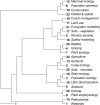75 years of dryland science: Trends and gaps in arid ecology literature
- PMID: 28384186
- PMCID: PMC5383157
- DOI: 10.1371/journal.pone.0175014
75 years of dryland science: Trends and gaps in arid ecology literature
Abstract
Growth in the publication of scientific articles is occurring at an exponential rate, prompting a growing need to synthesise information in a timely manner to combat urgent environmental problems and guide future research. Here, we undertake a topic analysis of dryland literature over the last 75 years (8218 articles) to identify areas in arid ecology that are well studied and topics that are emerging. Four topics-wetlands, mammal ecology, litter decomposition and spatial modelling, were identified as 'hot topics' that showed higher than average growth in publications from 1940 to 2015. Five topics-remote sensing, climate, habitat and spatial, agriculture and soils-microbes, were identified as 'cold topics', with lower than average growth over the survey period, but higher than average numbers of publications. Topics in arid ecology clustered into seven broad groups on word-based similarity. These groups ranged from mammal ecology and population genetics, broad-scale management and ecosystem modelling, plant ecology, agriculture and ecophysiology, to populations and paleoclimate. These patterns may reflect trends in the field of ecology more broadly. We also identified two broad research gaps in arid ecology: population genetics, and habitat and spatial research. Collaborations between population genetics and ecologists and investigations of ecological processes across spatial scales would contribute profitably to the advancement of arid ecology and to ecology more broadly.
Conflict of interest statement
Figures




Similar articles
-
The role of refuges in the persistence of Australian dryland mammals.Biol Rev Camb Philos Soc. 2017 May;92(2):647-664. doi: 10.1111/brv.12247. Epub 2015 Dec 21. Biol Rev Camb Philos Soc. 2017. PMID: 26685752 Review.
-
[Strengths, weaknesses, and opportunities of French research in trophic ecology].C R Biol. 2018 Jul-Aug;341(6):301-314. doi: 10.1016/j.crvi.2018.05.001. Epub 2018 May 30. C R Biol. 2018. PMID: 29859914 French.
-
Three-dimensional digital mapping of ecosystems: a new era in spatial ecology.Proc Biol Sci. 2020 Feb 12;287(1920):20192383. doi: 10.1098/rspb.2019.2383. Epub 2020 Feb 12. Proc Biol Sci. 2020. PMID: 32075534 Free PMC article.
-
The problem of pattern and scale in ecology: what have we learned in 20 years?Ecol Lett. 2013 May;16 Suppl 1:4-16. doi: 10.1111/ele.12048. Epub 2013 Jan 28. Ecol Lett. 2013. PMID: 23351093 Review.
-
Landscape dynamitic change in Mu Us Desert derived from Landsat TM data.J Environ Sci (China). 2003 Mar;15(2):222-6. J Environ Sci (China). 2003. PMID: 12765265
References
-
- Larsen PO, von Ins M. The rate of growth in scientific publication and the decline in coverage provided by Science Citation Index. Scientometrics. 2010;84(3):575–603. doi: 10.1007/s11192-010-0202-z - DOI - PMC - PubMed
-
- OECD. OECD Science, Technology and Innovation Outlook 2016. Paris: OECD Publishing; 2016.
-
- Van Noorden R, Brumfiel G. Fixing a grant system in crisis. Nature News. 2010;464(7288):474–5. - PubMed
-
- Neff MW, Corley EA. 35 years and 160,000 articles: a bibliometric exploration of the evolution of ecology. Scientometrics. 2009;80(3):657–82.
-
- Young RF, Wolf SA. Goal attainment in urban ecology research: A bibliometric review 1975–2004. Urban Ecosyst. 2006;9(3):179–93.
MeSH terms
LinkOut - more resources
Full Text Sources
Other Literature Sources

